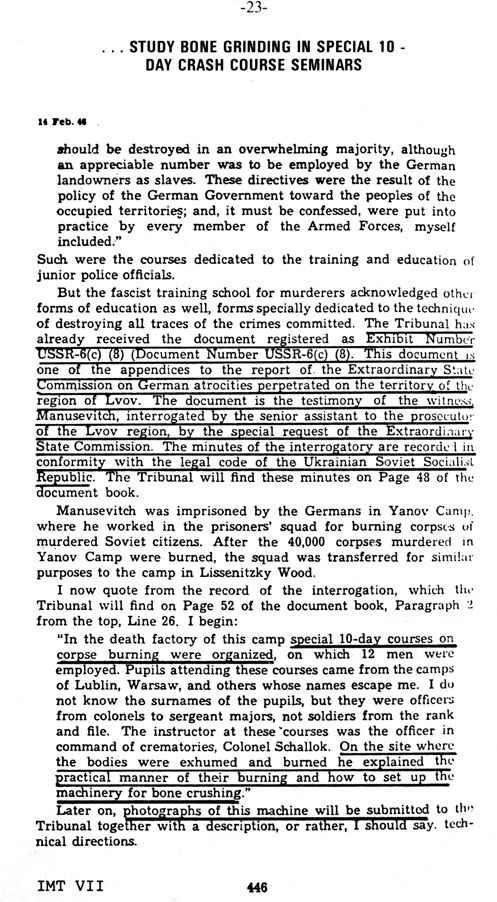
-23- |
... STUDY BONE GRINDING IN SPECIAL 10 IJAY CRASH COURSE SEMINARS |
14 Feb .46 |
should be destroyed in an overwhelming majority, although an appreciable number was to be employed by the German landowners as slaves. These directives were the result of the policy of the German Government toward the peoples of the occupied territories; and, it must be confessed, were put into practice by every member of the Armed Forces, myself included." Such were the courses dedicated to the training and education of junior police officials. But the fascist training school for murderers acknowledged other forms of education as well, forms specially dedicated to the technique of destroying all traces of the crimes committed. The Tribunal has already received the document registered as Exhibit Number USSR-6(c) (Document number USSR-6 (c) (8). This document is one of the appendices to the record of. the Extraordinary State Commission on German atrocities perpetrated on the territory of the region of Lvov. The document is the testimony of the witness Manuschevitch, interrog ated by the senior assistant to the Prosccutor of the Lvov region, by th special request of the extraordinary State Commission. The minutes of the interrogatory are recorded in conformity with the Penal Code of the Ukrainian Soviet Socialist Republic . The Tribunal will find these minutes on Page 48 of the document book. Manusevitch was imprisoned by the Germans in Yanov Camp, where he worked in the prisoners' squad for burning corpses vi murdered Soviet citizens. After the 40,000 corpses murdered In Yanov Camp were burned, the squad was transferred for similar purposes to the camp in Lissenitzky Wood. I now quote from the record of the interrogation, which the Tribunal will find on Page 52 of the document book, paragraph 2 from the top, line 26. I begin: "In the death factory of this camp special 10-day courses on corpse burning were organized, on which 12 men were employed. Pupils attending these courses came from the camps of Lublin, Warsaw, and others whose names escape me. I do not know the surnames of the pupils, but they were officers from colonels to sergeant majors, not soldiers from the rank and file. The instructor at these courses was the officer in command of crematories, Colonel Schallok. On the site where the bodies were exhumed and burned he explained the practical manner of their burning and how to set up the machinery for bone crushing ." Later on, photographs of this machine will be submitted to the Tribunal together with a description, or rather, should I say, technical directions. |
IMT VII |
446 |